Posted by: alien-ufo-pictures.com
Ancient Aliens, Ancient Ufo and Alien Drawings
This Ufo Artwork is Dated B.C. (before Christ). For artwork dated A.D (after death of Christ) click here or go farther down this page and click on Page 3.
IMPORTANT: One defining factor in many of these pictures is the Halo around the head of the alien. In my opinion this means that they are Angelic, like Angels, meaning from Heaven, (heaven-the sky-or the heavens).
 The Dropa Stones
The Dropa Stones
The story of the Dropa for us begins in the same place, but the year is 1938. The mountains are the Baian-Kara-Ula mountains on the border that divides China and Tibet. An archaeological expedition, led by Chi Pu Tei, has trudged into the barely accessible mountain range, and has happened upon some caves that had obviously been occupied by a primitive people long ago.On the walls were carved pictograms of the heavens: the sun, the moon, the stars, and the Earth with lines of dots connecting them. Then the team made the most incredible discovery of all. Half-buried in the dirt floor of the cave was an odd stone disk, obviously fashioned by the hand of an intelligent creature. The disk was approximately nine inches in diameter and three-quarters of an inch thick. In the exact center was a perfectly round, 3/4" hole, and etched in its face was a fine groove spiraling out from the center to the rim, making the disk look for all the world like some kind of primitive phonograph record.This one plate, dated to be between 10,000 and 12,000 years old , but the wonder was multiplied manifold. In all, 716 such plates were found. And each held an incredible secret. The groove, upon further inspection, was not a groove at all, but a continuous line of strange carved hieroglyphics - writing!
 Dr. Tsum Um Nui , in 1962, painstakingly transcribed the characters from the disk to paper. The writing was so small he had to use a magnifying glass to see it clearly. But the stones were old - perhaps 12,000 years old, it was estimated - and much of the hieroglyphics were difficult to make out or had been worn away by time and the elements. As he worked, many questions nagged the professor. How did these primitive people fashion these precise stones? How did they manage the almost microscopic writing? Who were they and what was the purpose of these hundreds of stones? Once the characters were transcribed, Dr. Tsum Um Nui began the arduous task of trying to decode its message. Eventually, he began to make progress. A word emerged. Then another. A phrase became understandable, then an entire sentence. He had broken the code. He discerned that the messages on the stones were written by a people who called themselves the Dropa. But what they were saying to him 12,000 years later made no sense. What the Dropa had written must have been one of their cultural myths, or was part of some prehistoric religious ceremony.
Dr. Tsum Um Nui , in 1962, painstakingly transcribed the characters from the disk to paper. The writing was so small he had to use a magnifying glass to see it clearly. But the stones were old - perhaps 12,000 years old, it was estimated - and much of the hieroglyphics were difficult to make out or had been worn away by time and the elements. As he worked, many questions nagged the professor. How did these primitive people fashion these precise stones? How did they manage the almost microscopic writing? Who were they and what was the purpose of these hundreds of stones? Once the characters were transcribed, Dr. Tsum Um Nui began the arduous task of trying to decode its message. Eventually, he began to make progress. A word emerged. Then another. A phrase became understandable, then an entire sentence. He had broken the code. He discerned that the messages on the stones were written by a people who called themselves the Dropa. But what they were saying to him 12,000 years later made no sense. What the Dropa had written must have been one of their cultural myths, or was part of some prehistoric religious ceremony.
Or was it? When he had completed the translation the professor wrote up a paper on his findings and presented it to the university for publication. Their reaction was swift and emphatic: the paper would not be published. The Academy of Prehistory expressly forbade him to publish or even speak of his findings. The world, the academy decided, should not know about the Dropa and their fateful journey to Earth.The Dropa disks tell the story of a space probe from a distant planet that crash-landed in the Baian-Kara-Ula mountains of the Himalayas. The occupants of the spacecraft - the Dropa - found refuge in the caves of the mountains.The stones go on to say how the Dropa were unable to repair their disabled spacecraft and could not return to their home planet, and so were stranded on Earth. If that's true, have their descendents survived?
![]() The Dogons
The Dogons
The Dogons are a people well known by their cosmogony, their esotericism, their myths and legends that interest foreigners at the highest point in search for culture or tourism.
The population is assessed to be about 300,000 people living in the South West of the Niger loop in the region of Mopti in Mali (Bandiagara, Koro, Banka), near Douentza and part of the North of Burkina (North west of Ouahigouya).
The Dogon's (Mali, Africa) homeland has been designated a World Heritage site for its cultural and natural significance. They are also famous for their artistic abilities and vast knowledge about astrology, especially the Sirius star, which is the center of their religious teachings. The Dogons know that Sirius A, the brightest system in our firmament, is next to a small white dwarf called Sirius B, which was not identified by western scientists until 1978. The Dogons knew about it at least 1000 years ago. Sirius B has formed the basis of the holiest Dogon beliefs since antiquity.
Western astronomers did not discover the star until the middle of the nineteenth century, and it wasn't even photographed until 1970.
The Dogons go as far as describing a third star in the Sirius system, called "Emme Ya" that, to date, has not been identified by astronomers. In addition to their knowledge of Sirius B, the Dogon mythology includes Saturn's rings and Jupiter's four major moons. They have four calendars, for the Sun, Moon, Sirius, and Venus, and have long known that planets orbit the sun.
How this Dogon's Enigmatic Scientific Knowledge about Astronomy came from?
According to their oral traditions, a race people from the Sirius system called the Nommos visited Earth thousands of years ago. The Nommos were ugly, amphibious beings that resembled mermen and mermaids. They also appear in Babylonian, Accadian, and Sumerian myths. The Egyptian Goddess Isis, who is sometimes depicted as a mermaid, is also linked with the star Sirius. The Nommos, according to the Dogon legend, lived on a planet that orbits another star in the Sirius system. They landed on Earth in an "ark" that made a spinning decent to the ground with great noise and wind. It was the Nommos that gave the Dogon the knowledge about Sirius B !
(Picture: The original Dogon couple.This is one of the greatest symbols of the Dogon civilization. Sculpting represents spouses)


These ufo petroglyphs were created thousands of years ago by ancient Indians in the American Southwest. According to Indian folklore, two objects collided high in the sky and one crash-landed in the region of Death Valley. Some men arrived (presumably in another ship) and spent some time repairing the damaged Craft and were observed by the local Indians. The two images below may possibly depict the ship (left) used by the men who came to repair the damaged craft. In comparing the two images, the one on the right seems to depict structural damage around the edges and the bottom. Could it be the one that allegedly crashed? The images are stills taken from an old TV series entitled "In search of..." hosted by Leonard Nimoy.

This is an artistic reproduction of a relief found in a labyrinth on the island Jotuo in the Toengt'ing lake. An expedition took place in 1957 (two years before an earthquake in that region). The expedition was led by professor Tsj'i Pen-Lai. They found various reliefs showing "humans" in strange clothes which looked like astronaut suits (hose like objects attached to the clothes). They also found a painting which apparently resembled the solar system. The third and fourth circle (planet) were connected with a line. Also there were ten planets (excluding the sun as planet). This connects easily to the theories about Nibiru, planet X, etc.

These are two cave paintings from Tanzania. Both are estimated to be up to 29,000 years old. The one on the left is located in Itolo and depicts several disc shaped objects. The other painting is from Kolo shows four entities surrounding a women. Notice also the entity looking down from inside some sort of box or object.



This two images are from France, the cave of "Pech Merle" near "Le Cabrerets" c.17,000 - 15,000 BC. The scene depicts a landscape full of wildlife together with a number of saucer shaped objects. The objects seem totally out of context.


These two examples of rock art are from Toro Muerto,Peru 12-14,000 years old. Notice the beings have some sort of halo or covering over their heads (compare with the Val Camonica photo below). Also, in the right hand picture there is some sort of object left of the main being. Possibly a UFO ?

This cave painting is c.10,000 BC and is from Val Camonica, Italy. It appears to depict two beings in protective suits holding strange implements.


Two images c.6000 BC from Tassili, Sahara Desert, North Africa. They do not look human do they ? Also notice the disk in the sky in left hand picture.

This strange suited figure was found in Kiev and I believe its dated to 4,000 BC.

This is a 7000 year petroglyph discovered in the province of Querato, Mexico in 1966. You can see 4 figures with their arms outstretched below a large oval object radiating what appear to be beams of light.

More strange looking figures (aliens) this time from Sego Canyon , Utah. Estimated up to 5,500 BC.



These are illustrations from a book by Lt. Grey. "Journals of Two Expeditions of Discovery in North-West and Western Australia 1837, 1838, & 1839". He led an expedition in the 19th century to some caves near the Glenelg River region of Kimberley, Northern Australia where he came across a series of cave paintings. The beings are called the Wandjina by the Aboriginies who painted them.



More examples of Wandjina. These a images from Kimberley, Australia. Possibly 5,000 years old. Some people believe they may represent ET beings. Notice how the ones in the middle and on the left resemble the head size of grey aliens.

The above photo is of a number of reptilian entities found in Iraq. They are dated at 5000-4500 BC. They are housed in the british museum.



These photos depict figures found in Equador. Notice they appear to be wearing space suits. You can see a comparison photo with an Apollo astronaut.
This page contains ancient drawings of both aliens and ufos. These drawings of ancient aliens are famous, and many of them are featured in museums and are also available to the general public through cave viewings. The depictions of aliens and ufos are obvious, thinking that these pictures and artwork represent other things is possible. However the more realistic idealogy is that these are things that these ancient people saw a long time ago and they represented them through drawings. Often times stories about ancient aliens accompany the drawings, some stories of ancient aliens were handed down generation to generation.
This Ufo Artwork is Dated A.D.

This is an old Chinese illustration from a fictional book entitled "Illustrated Survey of Weird Countries" (c.1400 A.D.) and had the following original caption: "Ji Gung Land: The people could make flying cars that travelled far with a suitable wind. In Tarng's day (c.1700 B.C.), Ji Gung people flying a car on a westerley reached Yew Jo. Tarng dismantled their car so it could not be demonstrated to the people ... Later an east wind came on which he had them fly the car back to their own country [5,000 km] west pf our gateway."

This artwork is alledgedly from the buddhist Dharamsala temple in Himachal Pradesh, India. This is where the Dalai Lama lives in exile. You can just make out six silvery saucer shaped objects.


These images of two crusaders date from a 12th century manuscript " Annales Laurissenses" (volumes/books about historical and religion events)and refer to a UFO sighting in the year 776, during the siege on Sigiburg castle, France. The Saxons besieged and surrounded the French people. They both were fighting when suddenly a group of discs (flaming shields) appeared hovering over the top of the church. It appeared to the Saxons that the French were protected by these objects and the Saxons fled.

This is an illustration depicting a sighting of a burning wheel in the year 900 over Japan.


The above image comes from the 10th Century Tibetan translation of the Sanskrit text "Prajnaparamita Sutra", held at a Japanese museum. In the enlargement you can see two objects that look like hats, but why are they floating in mid air ? also one of them appears to have port holes on it. Indian Vedic texts are full of descriptions of Vimanas. The Ramayana describes Vimanas as a double decked, circular or cylindrical aircraft with portholes and a dome. It flew with "the speed of the wind" and gave forth a "melodious sound".

This is an illustration of a sighting that occured in the french town of Angers in the year 842. I'm not sure when this illustration was done or who it was by however.


These two tapestries were created in the 15th century. Both depict the life of Mary. Hat shaped objects can be clearly seen in both tapestries.The one on the right is entitled "The Magnificat". Both are located at the french basillica Notre-Dame in Beaune, Burgandy.

This image cames from the french book "Le Livre Des Bonnes Moeurs" by Jacques Legrand. You can find this book in Chantilly Condé's Museum ref 1338 ,297 part 15 B 8. Some people say that the sphere is a balloon but there was no balloon in france in 1338 ...



The first picture shows a fresco entitled "The Crucifixion" and was painted in 1350. Two objects with figures inside can be seen in the top left and top right of the fresco. Two enlargements of these objects are shown above. The fresco is located above the altar at the Visoki Decani Monestary in Kosovo, Yugoslavia

The above painting is by Paolo Uccello (1396-1475) and is entitled "La Tebaide" (painted c.1460-1465). The blown up picture on the right shows a red saucer shaped UFO seen near Jesus. It hangs in the Academy of Florence.

This is a renaissance illustration of a UFO sighting in Rome detailed in a book "Prodigiorum liber" by Roman historian Julio Obsequens - "Something like a sort of weapon, or missile, rose with a great noise from the earth and soared into the sky".

February 1465. The above illustration is from Notabilia Temporum by Angelo de Tummulillis. It describes a flaming girder seen in the sky during the reign of Enrico IV. , looks similar to the object in the Obsequens picture above.


The above painting is by Carlo Crivelli (1430-1495) and is called "The Annunciation" (1486) and hangs in the National Gallery, London. A disk shaped object is shining a pencil beam of light down onto the crown of Mary's head. A Blow up of the object is next to the painting.

The above is a painting on wood drawer from furniture kept at the Earls D’Oltremond, Belgium. Moses is receiving the tablets and several objects in the sky are seen near by. Date and artist unknown. This supports the claims of many that many biblical events, can be further explained when ufos and aliens are taken into consideration, higher forms of technology could explain some of the events such as writing on stone with fire, parting the red sea, etc... higher forms of technology might explain how some of these feats were performed.

The above picture depicts Jesus and Mary on what appear to be lenticular clouds. The painting is entitled "The Miracle of the Snow" and was painted by Masolino Da Panicale (1383-1440) and hangs at the church of Santa Maria Maggiore, Florence, Italy.


This painting is called "The Madonna with Saint Giovannino". It was painted in the 15th century. The Palazzo Vecchio lists the artist as unknown although attributed to the Lippi school.Above Mary's right shoulder is a disk shaped object. Below is a blow up of this section and a man and his dog can clearly be seen looking up at the object.

The above picture is from a book entitled Prodigiorum Ac Ostentorum Chronicon by Conrad Lycosthenes (1518-1561). Basel: Henricpteri, 1557. It depicts a UFO sighting in Arabia in 1479. The book is held at the Australian Museum Research Library.

The above image is entitled "The Assumption of the Virgin" by ANON. Painted c.1490. Once again notice the discoidal clouds.

This is a 15th century fresco from Kiev. Seems to show Jesus in a rocket type device.

1660. The illustration depicts a sighting by two Dutch ships in the North Sea of an object moving slowly in the sky. It appeared to be made by two disks of different size. The source for this account is one of the books entitled :"Theatrum Orbis Terrarum" by Admiral Blaeu. These books were compilations of articles by different authors and consisted of detailed accounts of long engagements at sea, cartography information etc.

This is a tapestry called Summer's triumph and was created in Bruges in 1538. It now resides at the Bayerisches National Museum. You can clearly see several disc shaped objects in the top of the tapestry. Someone has speculated that they are islands, if so, then these islands are floating in the sky!

The above image is of an actual sighting that occurred in Nuremburg on the 14th April 1561. It appeared in a local broadsheet and was a woodcut by Hans Glasser. The globes, crosses and tubes began to fight one another, and this went on for an hour. Then they all fell to earth, as if on fire, and faded slowly away producing a lot of steam. Afterwards a black spear-like object was seen, and the whole event was taken to be a divine warning. Held at the Wickiana Collection, Zurich Central Library.

This broadsheet picture by Samuel Coccius illustrates a UFO sighting over Basel, Switzerland in 1566. 'Large black Globes' appeared in the skies. It is held at the Wickiana Collection, Zurich Central Library.

The above painting is by Bonaventura Salimbeni entitled "Glorification of the Eucharist", painted in 1600. Notice the Sputnik satellite device. It hangs in the church of San Lorenzo in San Pietro. It is considered by some to be a stylised representation of the Earth but I have included it here as it still looks interesting.

This is a French jeton minted in 1680, a coin-like educational tool that was commonly used to help people count money, or sometimes used as a money substitute for playing games. It is about the size of a U.S. quarter-dollar and similar to thousands of other jetons with different religious and educational designs that were produced and used in Europe during the 16th and 17th centuries. It appears to commemorate a UFO sighting of a wheel like object. Some researchers feel it represents the Biblical Ezekiel's wheel. The Latin inscription 'OPPORTUNUS ADEST' translates as 'It is here at an opportune time".



This is a 17th century fresco and is located in the Svetishoveli Cathedral in Mtskheta, Georgia. Notice the two saucer shaped objects either side of Christ. In the two blow ups you can see they contain faces.

More wheels! This picture shows a UFO sighting over Hamburg, Germany 4 November 1697. The objects were described as "two glowing wheels".

This image is by flemish artist Aert De Gelder and is entitled "The Baptism of Christ" It was painted in 1710 and hangs in the Fitzwilliam Musuem, Cambridge. A disk shaped object is shining beams of light down on John the Baptist and Jesus.


This is a scan from vol. 42 of the Philosophical Transactions 1742 describing a sighting that occured on the 16th December 1742. Alongside is a contemporary reconstruction depicting the object with the colours described.

The above illustration depicts a sighting that occurred at 9.45pm on the evening of 18th August 1783 when four witnesses on the terrace of Windsor Castle observed a luminous object in the skies of the Home Counties of England. The sighting was recorded the following year in the Philosophical Transactions of the Royal Society. According to this report, witnesses observed an oblong cloud moving more or less parallel to the horizon. Under this cloud could be seen a luminous object which soon became spherical, brilliantly lit, which came to a halt; This strange sphere seemed at first to be pale blue in colour but then its luminosity increased and soon it set off again towards the east. Then the object changed direction and moved parallel to the horizon before disappearing to the south-east ; the light it gave out was prodigious; it lit us everything on the ground.; The image was captured in this by Thomas Sandby (a founder of the Royal Academy) and his brother Paul, both of whom witnessed the event.

This is an illustration from a book "Ume No Chiri (Dust of Apricot)" published in 1803. A foreign ship and crew witnessed at Haratonohama (Haratono Seashore) in Hitachi no Kuni (Ibaragi Prefecture), Japan this strange object. According to the explanation in the drawing, the outershell was made of iron and glass, and strange letters shown in this drawing were seen inside the ship.
Article link: http://www.alien-ufo-pictures.com/ancient_aliens.html
Ancient Cave Paintings Depicting Aliens, UFO and Wormhole Found In Madhya Pradesh, India
Ancient Cave Paintings Depicting Aliens, UFO and Wormhole Found In Madhya Pradesh, India
 A group of anthropologists working with hill tribes in a remote area of India have made a startling discovery: Intricate prehistoric cave paintings depicting aliens and UFO type craft next to look-alike Wormhole formation in the sky.
A group of anthropologists working with hill tribes in a remote area of India have made a startling discovery: Intricate prehistoric cave paintings depicting aliens and UFO type craft next to look-alike Wormhole formation in the sky. The images was found in the Hoshangabad district of the state of Madhya Pradesh only 43 miles from the local administrative centre of Raisen. The caves are hidden deep within dense jungle.
The images was found in the Hoshangabad district of the state of Madhya Pradesh only 43 miles from the local administrative centre of Raisen. The caves are hidden deep within dense jungle.A clear image of what might be an alien or ET in a space suit can be seen in above cave painting along with a classical flying saucer shaped UFO that appears to be either beaming something down or beaming something up, in what might be an ancient UFO abduction scenario. A force-field or trail of some sort is seen at the rear of the UFO.
Also visible is another object that might depict a wormhole, explaining how aliens were able to reach Earth.
Down below is wormhole Time travel concept discussed by Stephen Hawking but in skeptic manner.
But isn't fascinating Indian Ancients witnessed wormholes, UFO and Alien visitations, while physicist like Stephen Hawking is still skeptic about wormhole and aliens.
Local Archaeologist, Mr Wassim Khan, has personally seen the images. He claims that the objects and creatures seen in them are totally anomalous and out of character when compared to other, already discovered, examples of prehistoric cave art depicting ancient life in the area. As such he believes that they might suggest beings from other planets have been interacting with humans since prehistoric times. Source
 Few years back, three and a half million years old Prehistoric human skull was discovered in Ahthnor village of Madhya Pradesh by geologist Dr. Arun Sonakia. It is possible that above image was drawn by those ancient humans.
Few years back, three and a half million years old Prehistoric human skull was discovered in Ahthnor village of Madhya Pradesh by geologist Dr. Arun Sonakia. It is possible that above image was drawn by those ancient humans.We think encounters like this and other help Indian ancient civilization to understand how those alien spaceship worked and later documented in Vimana shastra. Account like these add weight to the 'ancient astronaut theory' which postulates that human civilization was established with the assistance of benevolent space-faring aliens.
 The above image comes from the 10th Century Tibetan translation of the Sanskrit text "Prajnaparamita Sutra", held at a Japanese museum. In the enlargement you can see two objects that look like hats, but why are they floating in mid air ? also one of them appears to have port holes on it. Indian Vedic texts are full of descriptions of Vimanas. The Ramayana describes Vimanas as a double decked, circular or cylindrical aircraft with portholes and a dome. It flew with "the speed of the wind" and gave forth a "melodious sound".
The above image comes from the 10th Century Tibetan translation of the Sanskrit text "Prajnaparamita Sutra", held at a Japanese museum. In the enlargement you can see two objects that look like hats, but why are they floating in mid air ? also one of them appears to have port holes on it. Indian Vedic texts are full of descriptions of Vimanas. The Ramayana describes Vimanas as a double decked, circular or cylindrical aircraft with portholes and a dome. It flew with "the speed of the wind" and gave forth a "melodious sound". UFO visitation phenomena in Madhya Pradesh, India is still witnessed by many, in near by area till this date. The latest entrant to the list of people in Madhya Pradesh, who claim to have sighted unidentified Flying objects (UFO), is state Agriculture and Fisheries Minister Ramkrishna Kusmaria.
UFO visitation phenomena in Madhya Pradesh, India is still witnessed by many, in near by area till this date. The latest entrant to the list of people in Madhya Pradesh, who claim to have sighted unidentified Flying objects (UFO), is state Agriculture and Fisheries Minister Ramkrishna Kusmaria.Kusmaria said he spotted an UFO in Sukha village in Damoh district, about 135 miles from Ancient cave painting site, while on an official tour.
Kusmaria said he clearly saw the object in the sky, and it was emitting sharp sparks. (as also seen in image) “The object caused damage to the standing crops in the area (classic crop ircle phenomena) . I saw papaya fruits fell off the trees as the UFO passed by,” the minister said. read more
Petroglyphs - Pictographs - Cave Paintings - Geoglyphs
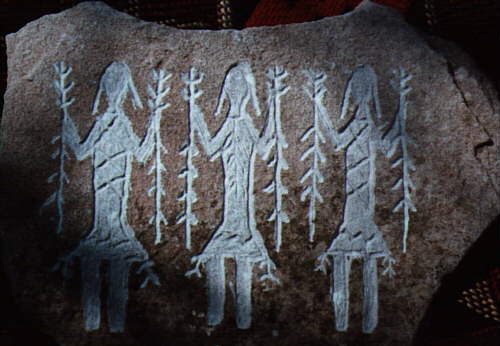
Petroglyphs - Rock Art
Petroglyphs are images incised in rock, usually by prehistoric, especially Neolithic, peoples. They were an important form of pre-writing symbols, used in communication from approximately 10,000 B.C.E. to modern times, depending on culture and location.
The word comes from the Greek words petros meaning "stone" and glyphein meaning "to carve" (it was originally coined in French as pétroglyphe).
The term 'petroglyph' should not be confused with pictograph, which is an image drawn or painted on a rock face, both of which contribute to the wider and more general category of rock art. Petroforms, or patterns and shapes made by many large rocks and boulders in rows over the ground, are also quite different.
The oldest petroglyphs are dated to approximately the Neolithic and late Upper Paleolithic boundary, about 10,000 to 12,000 years ago. Around 7,000 to 9,000 years ago, other writing systems such as pictographs and ideograms began to appear. Petroglyphs were still common though, and some less advanced societies continued using them much longer, even until contact with Western culture was made in the 20th century. Petroglyphs have been found in all parts of the globe except Antarctica with highest concentrations in parts of Africa, Scandinavia, Siberia, southwestern North America and Australia.
Interpretation
These images probably had deep cultural and religious significance for the societies that created them; in many cases this significance remains for their descendants. Many petroglyphs are thought to represent some kind of not-yet-fully understood symbolic or ritual language. Later glyphs from the Nordic Bronze Age in Scandinavia seem to refer to some form of territorial boundary between tribes, in addition to possible religious meanings. It also appears that local or regional dialects from similar or neighboring peoples exist. The Siberian inscriptions almost look like some early form of runes, although there is not thought to be any relationship between them. They are not yet well understood.
Some researchers have noticed the resemblance of different styles of petroglyphs across different continents; while it is expected that all people would be inspired by their surroundings, it is harder to explain the common styles. This could be mere coincidence, an indication that certain groups of people migrated widely from some initial common area, or indication of a common origin.
In 1853 George Tate read a paper to the Berwick Naturalists' Club at which a Mr John Collingwood Bruce agreed that the carvings had '.. a common origin, and indicate a symbolic meaning, representing some popular thought.' In his cataloguing of Scottish rock art, Ronald Morris summarised 104 different theories on their interpretation.
Other, more controversial, explanations are mostly grounded in Jungian psychology and the views of Mircea Eliade. According to these theories it is possible that the similarity of petroglyphs (and other atavistic or archetypal symbols) from different cultures and continents is a result of the genetically inherited structure of the human brain.
Other theories suggest that petroglyphs were made by shamans in an altered state of consciousness, perhaps induced by the use of natural hallucinogens. Many of the geometric patterns (known as form constants) which recur in petroglyphs and cave paintings have been shown to be "hard-wired" into the human brain; they frequently occur in visual disturbances and hallucinations brought on by drugs, migraine and other stimuli.
Present-day links between shamanism and rock-art amongst the San people of the Kalahari desert have been studied by the Rock Art Research Institute (RARI) of the University of the Witwatersrand. Though the San people's artworks are predominantly paintings, the beliefs behind them can perhaps be used as a basis for understanding other types of rock art, including petroglyphs.
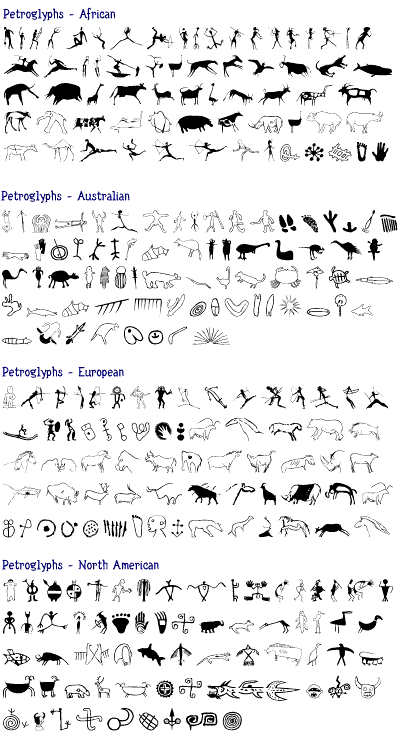
At the Ancient Ruins in West Central Idaho along the Snake River, the story of beings that came from the Stars and a Galactic War was recorded according to Indian Legend well over 30,000 years ago. The petroglyphs depict the beings that came, their interaction with the inhabitants of the ancient city, and the war and destruction that ensued. We are shown their ships which are curiously triangular in shape. Similar to those that have been recently sighted over Colorado, Arizona and California. We are also shown the portal through which the interdimensional beings came.
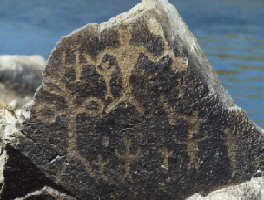
The waging of war between the Star Beings is recorded in the petroglyph to the right. The Star Beings and their counterparts, the two horned priests, are wreaking havoc upon the inhabitants of the Ancient City (represented by the smaller beings who are fleeing.)
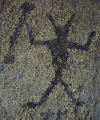
This petroglyph is located on a rock adjacent to the rock shown above. It depicts the two horned Priest. It should be noted that the dumbbell shaped apparatus held in his hand may represent an archtimeter. Reference to this can be found in Alice Bailey's writings, as well as in the hieroglyphs of Egypt. These tools are said to have wielded the power of life and death.
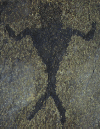
This being is very similar in appearance to Quetzalcoatl who is the Deity in the fabled city of Chichen Itza in Mexico, renowned for its Mayan Pyramids. He is often depicted at the controls of an ancient airship sometimes triangular in design.
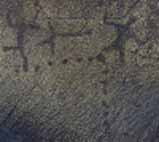
Star Beings emerging from triangular shaped ships
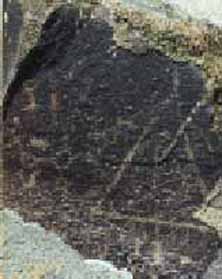
Possible triangular craft with retroflares
Figure inside - Beings Below
Left of the ship 4 entities - Hopi Petroglyphs
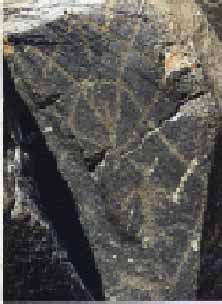
Possible Star Beings - Portal or UFO

The Yei are supernatural Holy People who communicate between the Navaho and their gods. They are usually shown carrying pine boughs, yucca strips and rattles in healing ceremonies. Each petroglyph is hand crafted reflecting images and messages inspired by the Ancient Ones. Native stones are carefully selected for each petroglyph with no two alike.
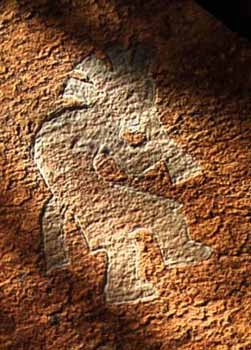
Kokopelli
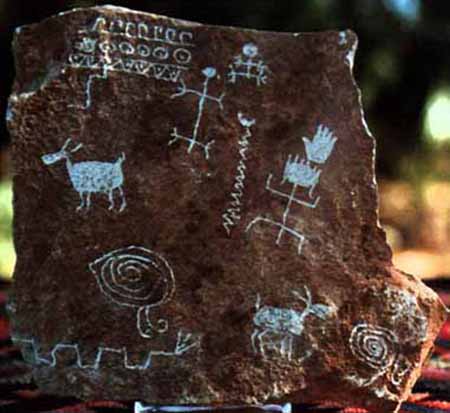
Kiva
Symbols from stone wall in the Village of the Great Kivas in New Mexico. Note the human, animal, snake and spiral figures were common to the area. Each petroglyph is hand crafted reflecting images and messages inspired by the Ancient Ones. Native stones are carefully selected for each petroglyph with no two alike.
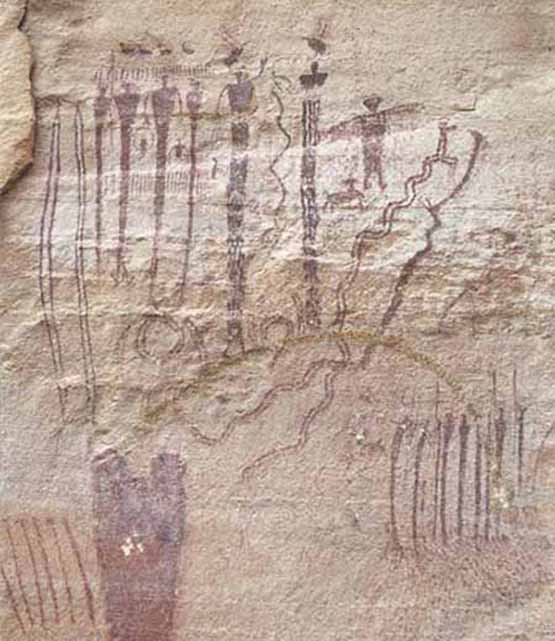
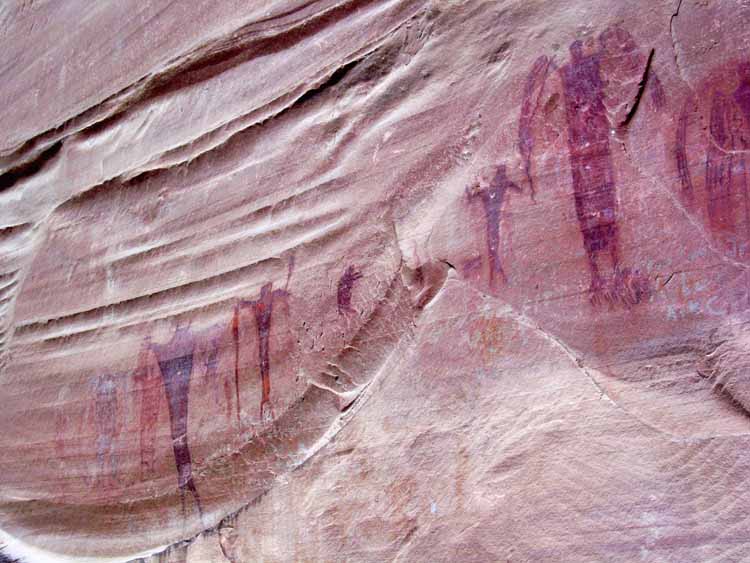
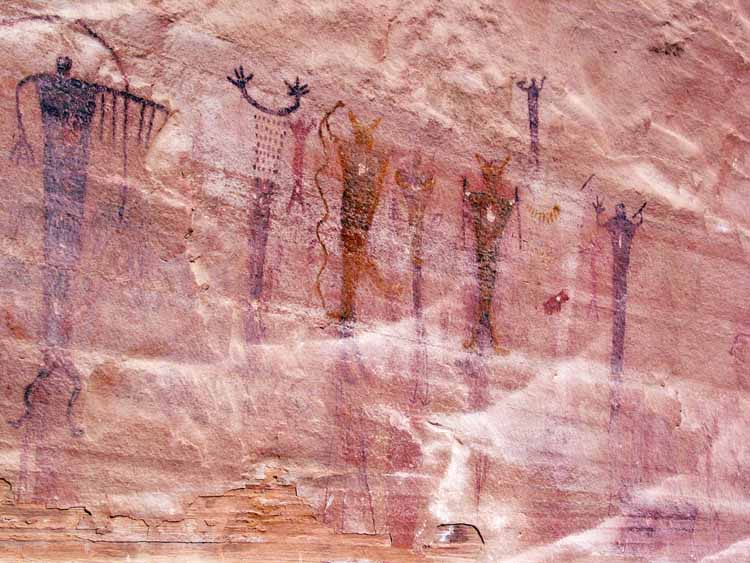
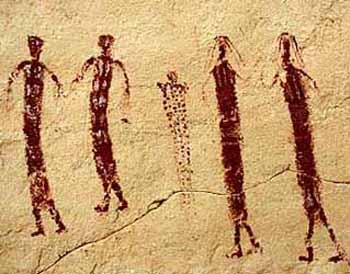
Two Males - Ascending Spirit - Two Females
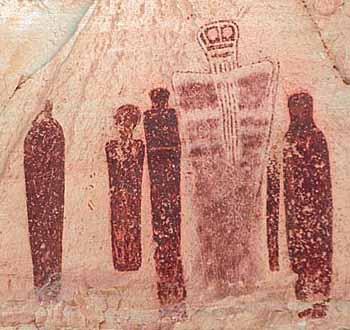
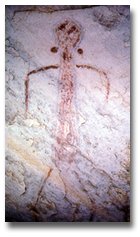
Rock Art in Arkansas
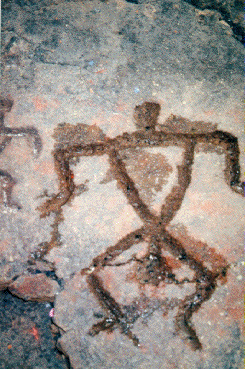
One of the many examples of Hawaiian ki`i pöhaku (petroglyphs - ancient rock carvings) found at Waikoloa. The Hawaiian petroglyphs contain many images of the human figure. It is possible that the images evolved in complexity from the simple angular figure to triangle figures and then to muscular figures. Notice the many angles in the petroglyph.
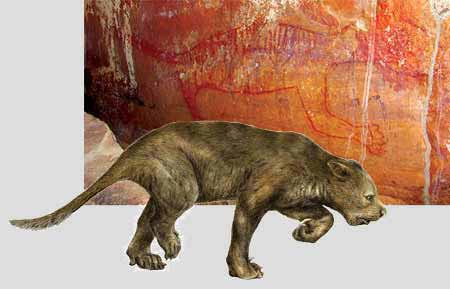
Cave Painting Depicts Extinct Marsupial Lion
Live Science - May 11, 2009
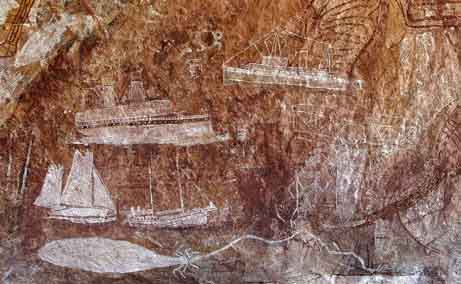
Unusual Rock Art Trove Found in Australia
National Geographic - October 22, 2008
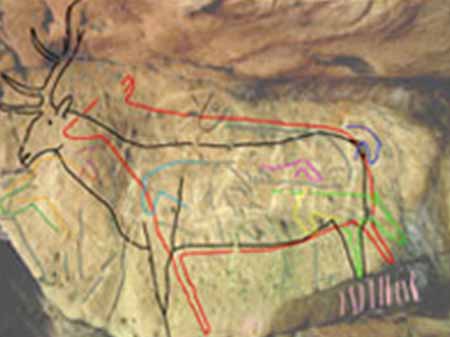
Experts put date to UK rock art - 12,800 years BBC - April 25, 2005
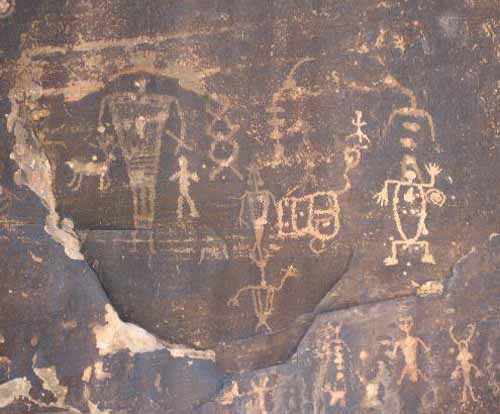
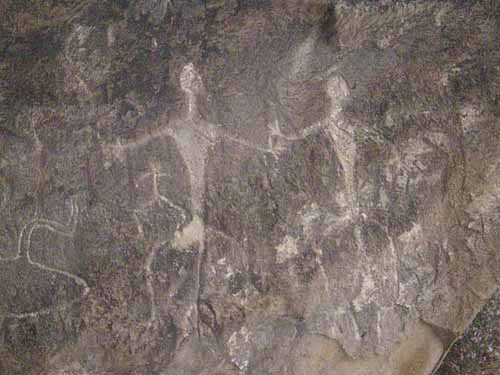
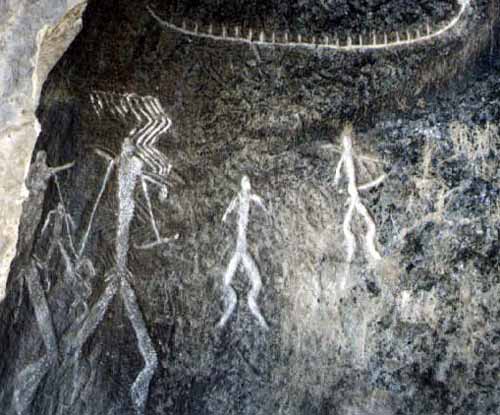
Stone Age petroglyphs Gobustan, Azerbaijan were not discovered by an archeological expedition. Their revelation came about quite by accident. In the 1930s, work was going on there in a stone quarry. The area is full of huge boulders and rock formations. One of the quarry workers noticed some unusual carvings on the rocks. The more the rocks were cut out, the more the paintings could be seen. (Before they had been hidden from view inside a huge pile of boulders.) Even more paintings were found inside what appeared to be man-made caves. Work at the quarry soon stopped so that the paintings could be examined more carefully.
In 1939, archeologist Isaak Jafarzade began the first archeological investigation of the petroglyphs at Gobustan. Between 1940 to 1965, teams identified and documented approximately 3,500 individual rock paintings on 750 rocks. The most ancient petroglyphs have been identified as belonging to the 12-8th century B.C. However, it is assumed that life existed here even earlier and that Gobustan was one of the cradles of civilization. This research was published in a book entitled "Gobustan" in 1978.
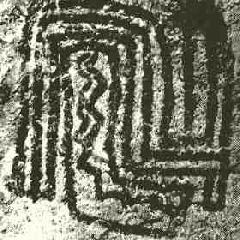
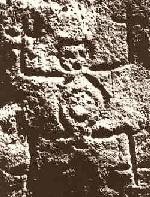
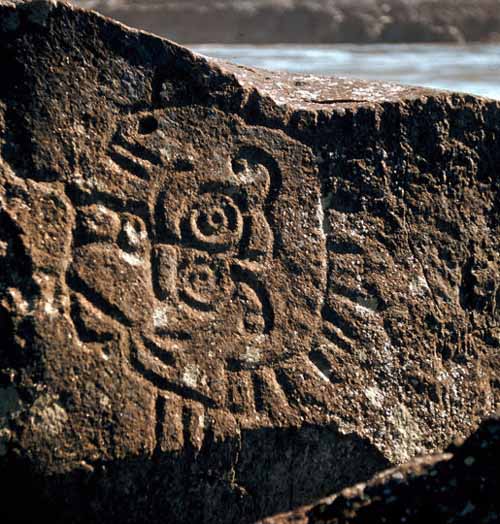
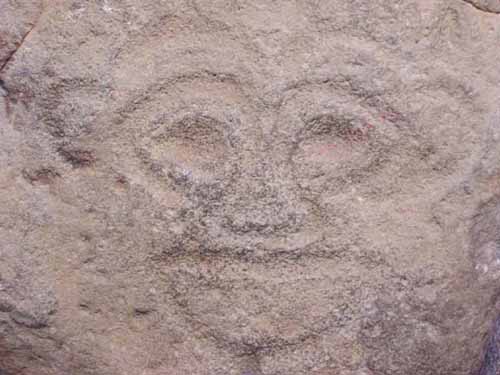
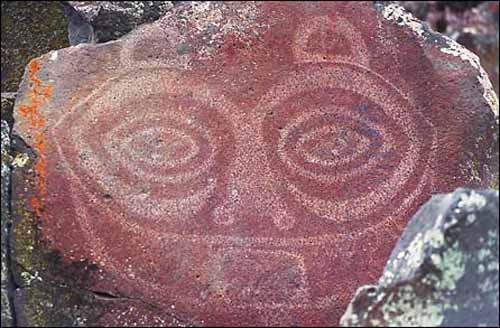
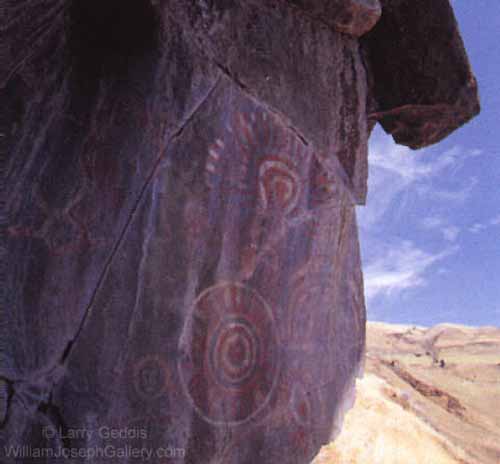
The activity of painting or engraving rocks in Colombia may have begun before the formative period. The scarce references seem to refer to activities which occurred much sooner than just a few years before the appearance of Spanish conquistadors. The differences in rock art themes, the variety of zones, the diversity of picture forms and engravings, seem to indicate that there existed long periods of rock art activity from the Paleoindian to the classic Muisca times. More than 700 pictograph and petroglyph zones have been discovered. Some rural traditions and beliefs have developed from some of the rock art design.
Pictograms - Pictographs
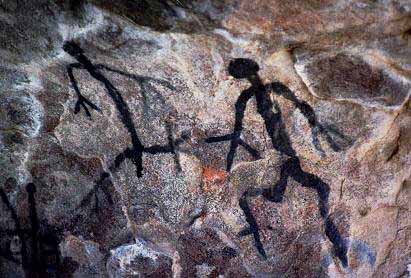
Pictographs are images painted on a rock face. Paints were generally made from pulverized minerals. Red, white, and black were the most common colors.
A pictogram or pictograph is a symbol representing an object or concept by illustration. Pictography is a form of writing whereby ideas are transmitted through drawing. It is the basis of cuneiform and hieroglyphs.
Early written symbols were based on pictograms, pictures which resemble what they signify, and ideograms, pictures which represent ideas; it is commonly believed that pictograms appeared before ideograms. They were used by various ancient cultures all over the world since around 9000 BC and began to develop into logographic writing systems around 5000 BC. Pictograms are still in use as the main medium of written communication in some non-literate cultures in Africa, The Americas, and Oceania, and are often used as simple symbols by most contemporary cultures.
The earliest uses of pictograms in Mesopotamia predated the famous Sumerian cuneiforms (oldest of which date to around 3400 BC). As far as around 9000 BC tokens marked with simple pictures began to be used to label basic farm produce, and around 6000 BC, with the rise of cities and spread of basic craftmanship more complex pictographic tokens were devised to label manufactured goods. Eventually, the tokens were replaced by clay tablets, on which symbols were drawn with a blunt reed called a stylus. The impressions left by the stylus were wedge shaped, thus giving rise to the name cuneiform, wedge-writing.
Though written Chinese is often thought of consisting of pictograms, less than 1% of all characters ever created have their direct origins in pictograms. The letters of the Roman alphabet, however, do have their origins in pictograms. For example, the letter A represented the head of an ox, and if it is turned upside down, a bovine head with horns can be seen.
Pictograms remain in common use today, serving as signs or instructions. Because of their graphical nature and fairly realistic style, they are widely used to indicate public toilets, or places such as airports and train stations. However, even these symbols are highly culture-specific. For example, in some cultures men commonly wear dress-like clothing, so even restroom signage is not universal. Pictographic writing as a modernist poetic technique is credited to Ezra Pound though French surrealists accurately credit the Pacific Northwest American Indians of Alaska who introduced writing, via totem poles, to North America (Reed 2003,p.XIX).
A standard set of pictograms was defined in the international standard ISO 7001: Public Information Symbols. Another common set of pictograms are the laundry symbols used on clothing tags and chemical hazard labels.In countries or regions where two or more languages are used, the typical traffic sign is very often a symbol with no writing on it. This is the case for much of Europe and several parts of Canada. Many of these signs, however, offer an abstract symbol instead of a picture, and they cannot be considered true pictograms.
Cave Paintings
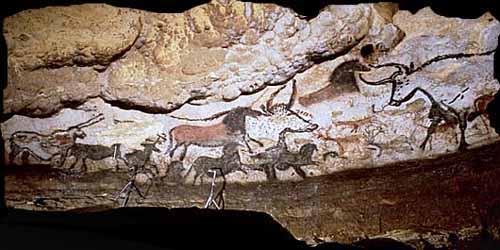
Cave or rock paintings are paintings painted on cave or rock walls and ceilings, usually dating to prehistoric times. Rock paintings are made since the Upper Paleolithic, 40,000 years ago. It is widely believed that the paintings are the work of respected elders or shamans.
When Europeans first encountered the Magdalenian paintings of the Altamira cave, Cantabria, Spain in 1879, they were considered to be hoaxes by academics. The new Darwinian thinking on evolution was interpreted as meaning that early humans could not have been sufficiently advanced to create art. Emile Cartailhac, one of the most respected prehistorians of the late nineteenth century believed they had been thought up by Creationists to support their ideas and ridicule Darwin's. Recent reappraisals and increasing numbers of discoveries have illustrated their authenticity and indicated the high levels of artistry of Upper Palaeolithic humans who used only basic tools. Cave paintings can also give valuable clues as to the culture and beliefs of that era.
The age of the paintings in many sites remains a contentious issue, since methods like radiocarbon dating can be easily misled by contaminated samples of older or newer material, and caves and rocky overhangs are typically littered with debris from many time periods. The choice of subject matter can indicate date such as the reindeer at the Spanish cave of Cueva de las Monedas which imply the art is from the last ice age. The oldest cave is that of Chauvet, and is 32,000 years old.
The most common themes in cave paintings are large wild animals, such as bison, horses, aurochs, and deer, and tracings of human hands as well as abstract patterns, called Macaroni by Breuil. Drawings of humans are rare and are usually schematic rather than the more naturalistic animal subjects. Cave art may have begun in the Aurignacian period (Hohle Fels, Germany), but reached its apogee in the late Magdalenian (Lascaux, France).
The paintings were drawn with red and yellow ochre, hematite, manganese oxide and charcoal. Sometimes the silhouette of the animal was incised in the rock first. Stone lamps provided some light. Abbé Breuil interpreted the paintings as being hunting magic, meant to increase the number of animals. As there are some clay sculptures that seem to have been the targets of spears, this may partly be true, but does not explain the pictures of beasts of prey such as the lion or the bear.An alternative and more modern theory, based on studies of more modern hunter-gatherer societies, is that the paintings were made by Cro-Magnon shaman.
The shaman would retreat into the darkness of the caves, enter into a trance state and then paint images of their visions, perhaps with some notion of drawing power out of the cave walls themselves. This goes some way towards explaining the remoteness of some of the paintings (which often occur in deep or small caves) and the variety of subject matter (from prey animals to predators and human hand-prints). However, as with all prehistory, it is impossible to be certain due to the relative lack of material evidence and the many pitfalls associated with trying to understand the prehistoric mindset with a modern mind.
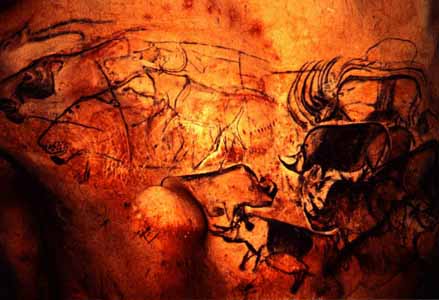
Lascaux is a complex of caves in southwestern France famous for its cave paintings. The original caves, located near the village of Montignac. They contain some of the earliest known art, dating back to somewhere between 13,000 and 15,000 BCE, or as far back as 25,000 BCE.
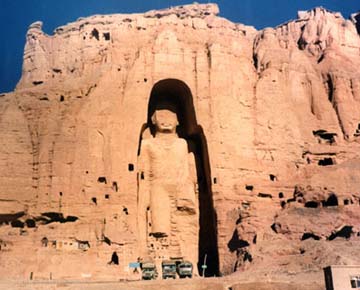
Earliest Oil Paintings Found in Famed Afghan Caves
National Geographic - February 7, 2008
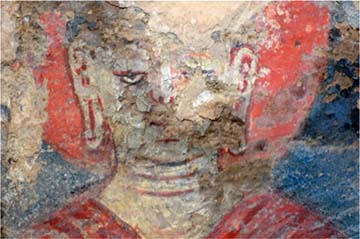
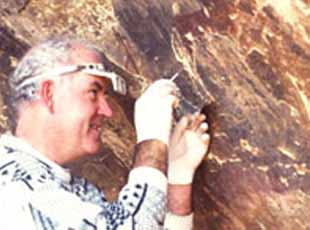
New light shed on South African cave art
BBC - February 7, 2004
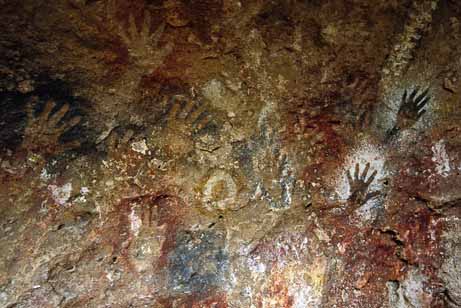
Hand Stencils Through Time National Geographic - June 26, 2009
Clusters of hand stencils dating back 2,500 years cover the walls of
Argentina's Cueva de las Manos -- Cave of the Hands in Patagonia.
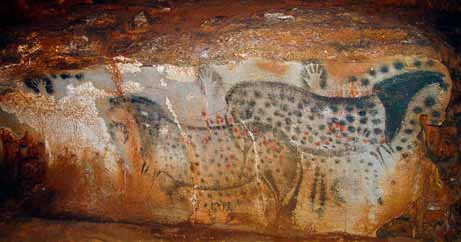
Prehistoric European Cave Artists Were Female
National Geographic - June 26, 2009
Inside France's 25,000-year-old Pech Merle cave,
hand stencils surround the famed "Spotted Horses" mural.
Geoglyph
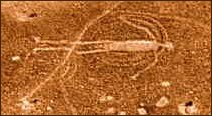
A geoglyph is a drawing on the ground, or a large motif, (generally greater than 4 metres) or design produced on the ground, either by arranging clasts (stones, stone fragments, gravel or earth) to create a positive geoglyph (stone arrangement/alignment, petroform, earth mound) or by removing patinated clasts to expose unpatinated ground (negative geoglyph).
Some of the most famous negative geoglyphs are the Nazca Lines in Peru. Other areas with geoglyphs include Western Australia. Hill figures, turf mazes and the stone-lined labyrinths of Scandinavia, Iceland, Lappland and the former Soviet Union are types of geoglyph. The largest geoglyph is the Marree Man in South Australia.
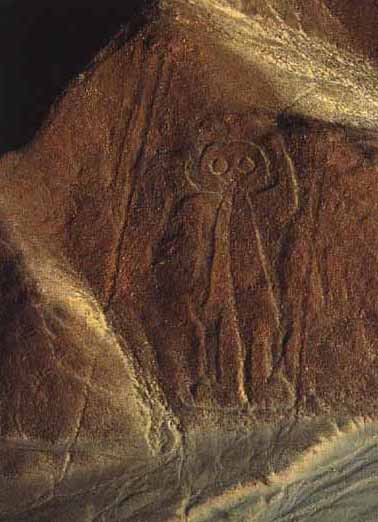
Nazca Lines
Article Link: http://www.crystalinks.com/petroglyphs.html
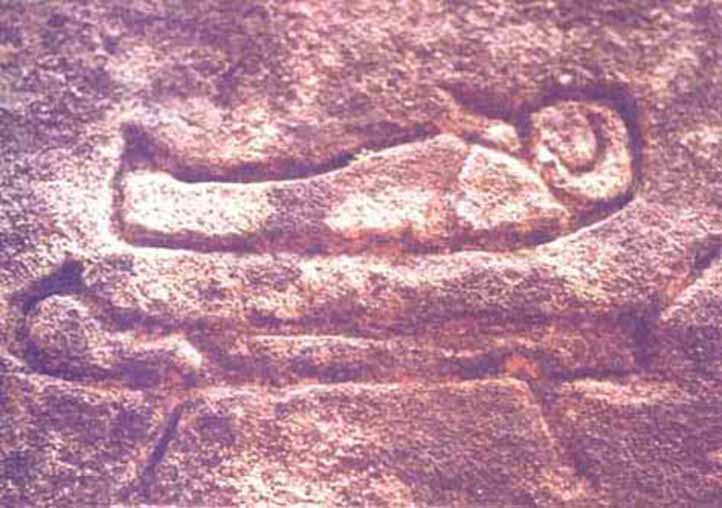
Tnx So much
ReplyDeleteThanks so much. I've seen some of this in pieces before, but now am further overwhelmed. So much that my 81-year-old brain is accepting some pretty wierd stuff.
ReplyDeleteLine all this up with the fact that the Great Pyramid was drowned in ca. 12,000-10,000 bc when the Nile rose 400 feet (so who built it when) and the wonderful tales of the Dogon who first led me out of conventional wisdom. As you have, too.
Don't stop.
John Wheeler